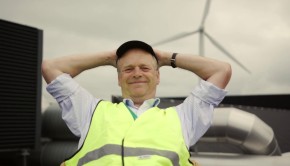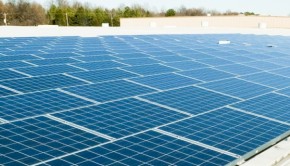As Coal Crashes, US Governors Push Wind Energy
December 5th, 2014 by Tina Casey
Forget the annual war on Christmas, things are really cooking up over the war on wind energy. The fight over wind energy has become something of a new American holiday ritual around this time of year, and now the stakes are higher than ever.
In the latest twist, a coalition of US Governors has waded into the fray with a letter to House leadership, citing a drop — yes, a drop — in electricity prices over the past five years, in states that have been producing more wind energy.
What’s All This About A Tax Break For Wind Energy?
For those of you new to the topic, the big wind energy blowup is all over a tax break called the production tax credit (PTC) for wind energy.
As a matter of sound public policy, namely, for economic development and national defense, Congress routinely exercises its ability to support domestic energy production through various subsidies, including tax breaks. For generations, that kind of nanny-state coddling was pretty much exclusively directed at fossil fuels and nuclear energy.
In 1992, Congress passed the first PTC for wind energy as a temporary kickstart to help get the nascent industry on a level footing with other energy sectors. The credit was routinely extended, along with virtually every other energy subsidy, with support from red and blue lawmakers alike.
The initial champion of the PTC for wind was (and still is) Iowa Republican Senator Chuck Grassley. Here he is explaining the legislative intent in an interview with The Toledo Chronicle a couple of years ago:
… [A]s much energy as possible, both traditional and renewable, should be produced at home to create jobs and strengthen national security. Wind energy is a free resource, and it’s abundant in many places around the country … [A] clean renewable source like wind is not dependent on far-away countries with leaders who are hostile to the United States even as they take our energy dollars.
Who could hate it? Nevertheless, as with all things Obama, support for what was in essence a good, solid Republican idea (Affordable Care Act, much?) withered to the point of extinction among Republican leadership in Congress after the President took office in 2009.
So now, every time the PTC for wind energy comes up for renewal, there is a huge knock ‘em down, drag ‘em out fight.
Republican Governors For Wind Power!
Despite some ham-handed attempts at monkey-wrenching the wind energy sector by our friends over at Koch Industries, there’s no arguing with the economic track record of wind energy now that the technology has matured.
That’s why you’ll find a much more bipartisan effort at the state level, in the form of the Governor’s Wind Energy Coalition.
The current membership is a healthy purple, including Arkansas, Kansas, New Mexico, South Dakota, California, Kentucky, New York, Washington, Colorado, Maryland, North Dakota, Delaware, Massachusetts, Oklahoma, Hawaii, Michigan, Oregon, Illinois, Minnesota, Pennsylvania, Iowa, Montana, and Rhode Island.
Check out this interactive map from the American Wind Energy Association and you’ll get the a similar red+blue= purple picture in terms of job creation and economic activity.
Not for nothing, but as a counterbalance to the Koch brothers the Governors Wind Energy Coalition’s smallish group of corporate affiliate members also includes MidAmerican Energy. Yes, that MidAmerican Energy.
In a letter to House and Senate leaders dated December 2, the Coalition urged another extension for the PTC for wind energy, citing these highlights as “directly attributable to the PTC” (breaks added for readability):
Today, 26 percent of South Dakota’s power generation comes from wind. In Washington State, developers added 2,800 megawatts of wind energy between 2001-2012…
Oregon generates over 12 percent of its electricity from wind…
In Iowa, where 27 percent of the state’s electricity generation comes from wind, MidAmerican Energy made the largest capital investment in the state’s history — building a wind farm that will add over $2 billion to Iowa’s economy.
The Coalition also hints at the ripple effect of all this activity on other economic sectors, which could get a boost from lower energy costs. According to their figures, states that produce seven percent or more of their electricity from wind have seen the price of electricity drop over the past five years. Meanwhile, prices have gone up in other states.
Death Blow For Coal
No, we didn’t forget about coal. Domestic consumption of coal has stalled out and is on the verge of dropping off the cliff. Although wind energy and other renewable sources have been blamed in some quarters, natural gas has actually been the biggest headache for coal producers.
We’re waiting for the other shoe to drop, as today’s glut-fired cheap natural gas heads into the inevitable cycle of falling production and rising prices. All else being equal, that would be good news for coal, but that’s where the game-changing aspect of renewable energy comes in: you’re not going to see that same kind of boom and bust cycle, since the source is free.
Meanwhile, coal has sunk into the doldrums. According to the latest Federal Energy Regulatory Commission report, no new coal powered generating plants have been put in service or expanded this year, through October. Yes, that would be zero.
Natural gas weighed in at 45 units for an installed capacity of 5,373 megawatts during the same period.
Renewables have also fared well so far in 2014. Solar and biomass have been leading the pack in terms of units, but FERC toted up 2,189 megawatts for wind energy, beating the other two by a wide margin and looking pretty good against natural gas.
As for coal facing more competition from wind energy, you ain’t seen nothing yet. The wind industry has been expanding exponentially without even beginning to tap into the country’s vast offshore wind energy resources, so hold onto your hats.
Follow me on Twitter and Google+.
Keep up to date with all the hottest cleantech news by subscribing to our (free) cleantech newsletter, or keep an eye on sector-specific news by getting our (also free) solar energy newsletter, electric vehicle newsletter, or wind energy newsletter.
-
eveee
-
eveee
-
http://zacharyshahan.com/ Zachary Shahan
-
eveee
-
http://zacharyshahan.com/ Zachary Shahan
-
-
-
-
eveee
-
http://zacharyshahan.com/ Zachary Shahan
-
eveee
-
http://zacharyshahan.com/ Zachary Shahan
-
-
-
-
eveee
-
Will E
-
-
Bruce Morgan Williams
-
Bob_Wallace
-
David in Bushwick
-
Bob_Wallace
-
Bob_Wallace
-
eveee
-
http://zacharyshahan.com/ Zachary Shahan
-
-
http://zacharyshahan.com/ Zachary Shahan
-
-
-
David in Bushwick
-
http://zacharyshahan.com/ Zachary Shahan
-
Bob_Wallace
-
http://zacharyshahan.com/ Zachary Shahan
-
-
-
-
harisA
-
Bob_Wallace
-
David in Bushwick
-
Bob_Wallace
-
-
harisA
-
Bob_Wallace
-
harisA
-
-
David in Bushwick
-
Will E
-
David in Bushwick
-
-
-
-
eveee
-
http://zacharyshahan.com/ Zachary Shahan
-
Steven F
-
Bob_Wallace
-
-
-
Michael G
-
Larmion
-
-
Bob_Wallace
-
Mike333
-
Larmion
-
Bob_Wallace
-
Larmion
-
JamesWimberley
-
-
Will E
-
-
-
-
Larmion
-
onesecond
-
Larmion
-
Matt
-
Bob_Wallace
-
eveee
-
http://zacharyshahan.com/ Zachary Shahan
-
-
Will E
-
JamesWimberley
-
Ronald Brakels
-
-
-
Bob_Wallace
-
-
Matt
-
eveee
-
http://zacharyshahan.com/ Zachary Shahan
-
eveee
-
http://zacharyshahan.com/ Zachary Shahan
-
-
-
-
Bob_Wallace
-
JamesWimberley
-
Bob_Wallace
-
Bruce Morgan Williams
-
Bob_Wallace
-
eveee
-
eveee
-
-
Ronald Brakels
-
Joseph Dubeau
-
Bob_Wallace
-
Ronald Brakels
-
-
-
Bob_Wallace
-
Larmion
-
Bob_Wallace
-
Will E
-
-
-
Will E
-


























